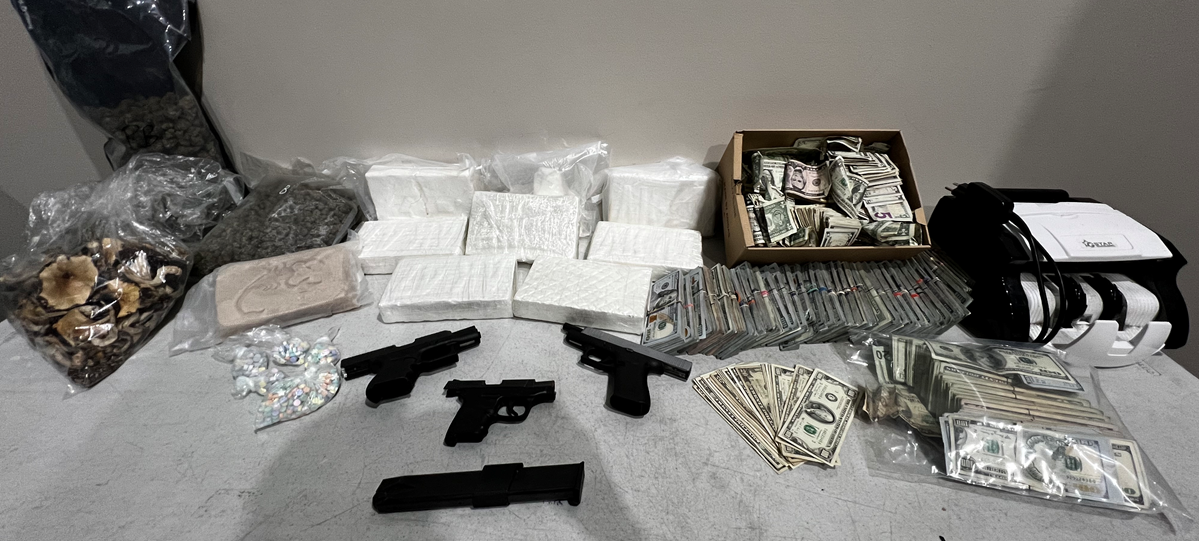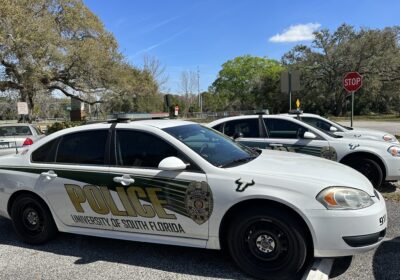Four charged with fentanyl distribution after USF student’s deadly overdose

Four people are charged with fentanyl distribution after an investigation into the February death of a USF student revealed he consumed a deadly dose, according to law enforcement agencies.
The student was found dead on Feb. 16 at Endeavor Hall. University Police (UP) and the Hillsborough County Sheriff’s Office found a “sophisticated” drug ring through an undercover investigation, Roger Handberg, the U.S. Attorney for the Middle District of Florida, said in Thursday’s press conference.
Related: USF student pronounced dead at Endeavor hall, police say – The Oracle
Darrius Gustafson, 20, David Chudhabuddhi, 37, Marquise Trant, 35, and Miguel Cintron, 36, are charged with distribution of fentanyl over 40 grams and conspiracy to distribute fentanyl resulting in death.
A nine-count indictment was returned from a federal grand jury last week charging the men. Handberg summarized the grand jury indictment and court documents in the press conference.
Cintron also faces additional counts of intent to distribute over 5 kilograms of cocaine and possession of a firearm as a felon. If the four are convicted on all counts, they face a minimum of 20 years in prison or a maximum life sentence, according to a press release.
The victim unknowingly purchased fentanyl, a highly addictive and potentially lethal narcotic, from Gustafson, a 20-year-old who lives one mile from campus. Handberg said the student believed he was purchasing Percocet, another narcotic commonly used as a painkiller.
The Oracle has chosen not to name the victim for privacy reasons.
UP Chief of Police Chris Daniel said this was an isolated issue at USF.
“It is our hope that the family of the student can find solace and move another step forward in the healing process knowing that those responsible are being brought to justice,” Daniel said.
Handberg said drug dealers are pressing pills to look like legitimate drugs, “often using fentanyl as part of their deadly mix.”
An autopsy revealed the student had no other “lethal drugs in his system at the time and died from an accidental overdose,” Handberg said.
Daniel said, at the time, there were no signs of foul play.
“This is not something that happens on our campus as a matter of regular business,” he said. “Nevertheless, we are an open campus and our students do travel into the community and the community does come onto campus, so it is something we have to be aware of.”
Following the student’s death, the sheriff’s office, with the help of UP, the FBI and Bureau of Alcohol, Tobacco, Firearms and Explosives, began several undercover purchases. Gustafson sold fentanyl that looked like Percocet to undercover law enforcement officers, Handberg said.
The investigation revealed that Gustafson received the fentanyl from Chudhabuddhi, who was working alongside Trant. Both Trant and Chudhabuddi, who have pleaded not guilty, were given the drug by Cintron.
Gustafson has also pleaded not guilty.
After the arrests, law enforcement found Cintron was in possession of firearms, 1 kilogram of heroin, 1 kilogram of black tar heroin, 7 kilograms of cocaine, 1,200 fentanyl pills and over $200,000 in cash, according to a press release.
Handberg said he believes fentanyl is the deadliest drug threat the country has ever faced. He said fentanyl caused over 5,600 deaths in Florida in 2022.
This nationwide increase in fentanyl-related deaths prompted these cases to be tried in federal court, Handberg said. He said fentanyl is the leading cause of death among 18 to 44-year-old Americans and a “major contributor” to the opioid epidemic.
“Because of the terrible toll that fentanyl has taken on communities that my office serves, my office has increased our resources to prosecute more of those cases in federal court,” Handberg said.
Handberg’s district is the second largest in the country, covering 13 million people. Over the past two fiscal years, law enforcement has seized enough fentanyl “to kill every single person in this district five times over,” Handberg said.
“One pill can kill,” Handberg said. “You’re making a choice, and it could possibly be a deadly choice because fentanyl is unforgiving.”
Correction: An earlier version of this article identified Chris Daniel as UP’s Chief of Public Safety.








